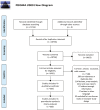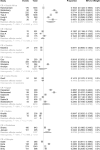Mapping global prevalence of depression among postpartum women
- PMID: 34671011
- PMCID: PMC8528847
- DOI: 10.1038/s41398-021-01663-6
Mapping global prevalence of depression among postpartum women
Erratum in
-
Correction: Mapping global prevalence of depression among postpartum women.Transl Psychiatry. 2021 Dec 20;11(1):640. doi: 10.1038/s41398-021-01692-1. Transl Psychiatry. 2021. PMID: 34930896 Free PMC article. No abstract available.
Abstract
Postpartum depression (PPD) is the most common psychological condition following childbirth, and may have a detrimental effect on the social and cognitive health of spouses, infants, and children. The aim of this study was to complete a comprehensive overview of the current literature on the global epidemiology of PPD. A total of 565 studies from 80 different countries or regions were included in the final analysis. Postpartum depression was found in 17.22% (95% CI 16.00-18.51) of the world's population. Meta-regression analysis showed that study size, country or region development, and country or region income were the causes of heterogeneity. Multivariable meta-regression analysis found that study size and country or area development were the most important predictors. Varied prevalence rates were noted in geographic regions with the highest rate found in Southern Africa (39.96%). Of interested was a significantly lower rate of PPD in developed countries or high-income countries or areas. Furthermore, the findings showed that there was a substantial difference in rates of PPD when marital status, educational level, social support, spouse care, violence, gestational age, breast feeding, child mortality, pregnancy plan, financial difficulties, partnership, life stress, smoking, alcohol intake, and living conditions were considered in the pooled estimates. Our results indicated that one out of every five women experiences PPD which is linked to income and geographic development. It is triggered by a variety of causes that necessitate the attention and committed intervention of primary care providers, clinicians, health authorities, and the general population.
© 2021. The Author(s).
Conflict of interest statement
The authors declare no competing interests.
Figures

















References
-
- Crotty F, Sheehan J. Prevalence and detection of postnatal depression in an Irish community sample. Ir J Psychol Med. 2004;21:117–21. - PubMed
-
- Cooper PJ, Murray L, Wilson A, Romaniuk H. Controlled trial of the short- and long-term effect of psychological treatment of post-partum depression. I. Impact on maternal mood. Br J Psychiatry. 2003;182:412–9. - PubMed
-
- Cox JL, Murray D, Chapman G. A controlled study of the onset, duration and prevalence of postnatal depression. Br J Psychiatry. 1993;163:27–31. - PubMed
-
- Lovestone S, Kumar R. Postnatal psychiatric illness: the impact on partners. Br J Psychiatry. 1993;163:210–6. - PubMed

